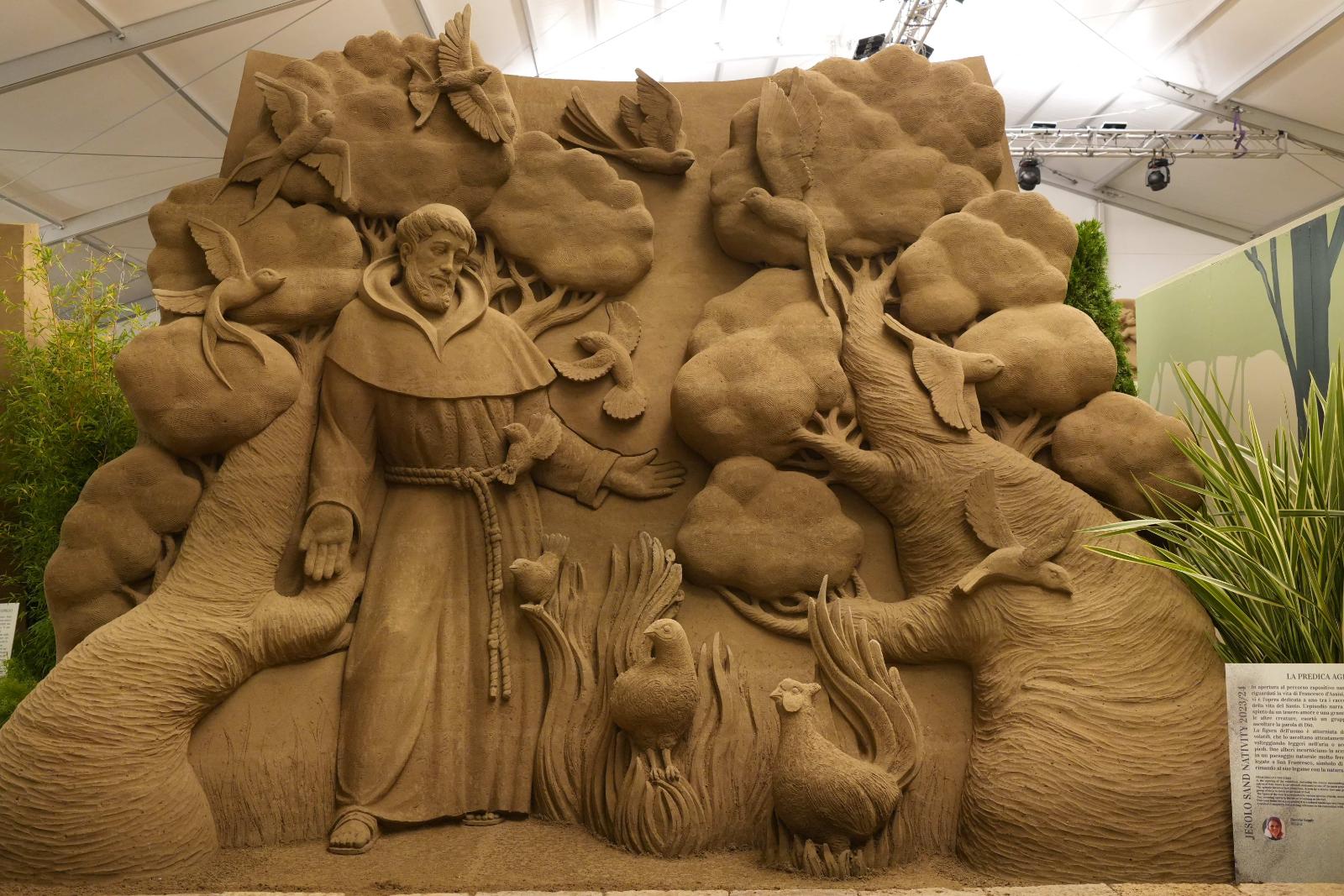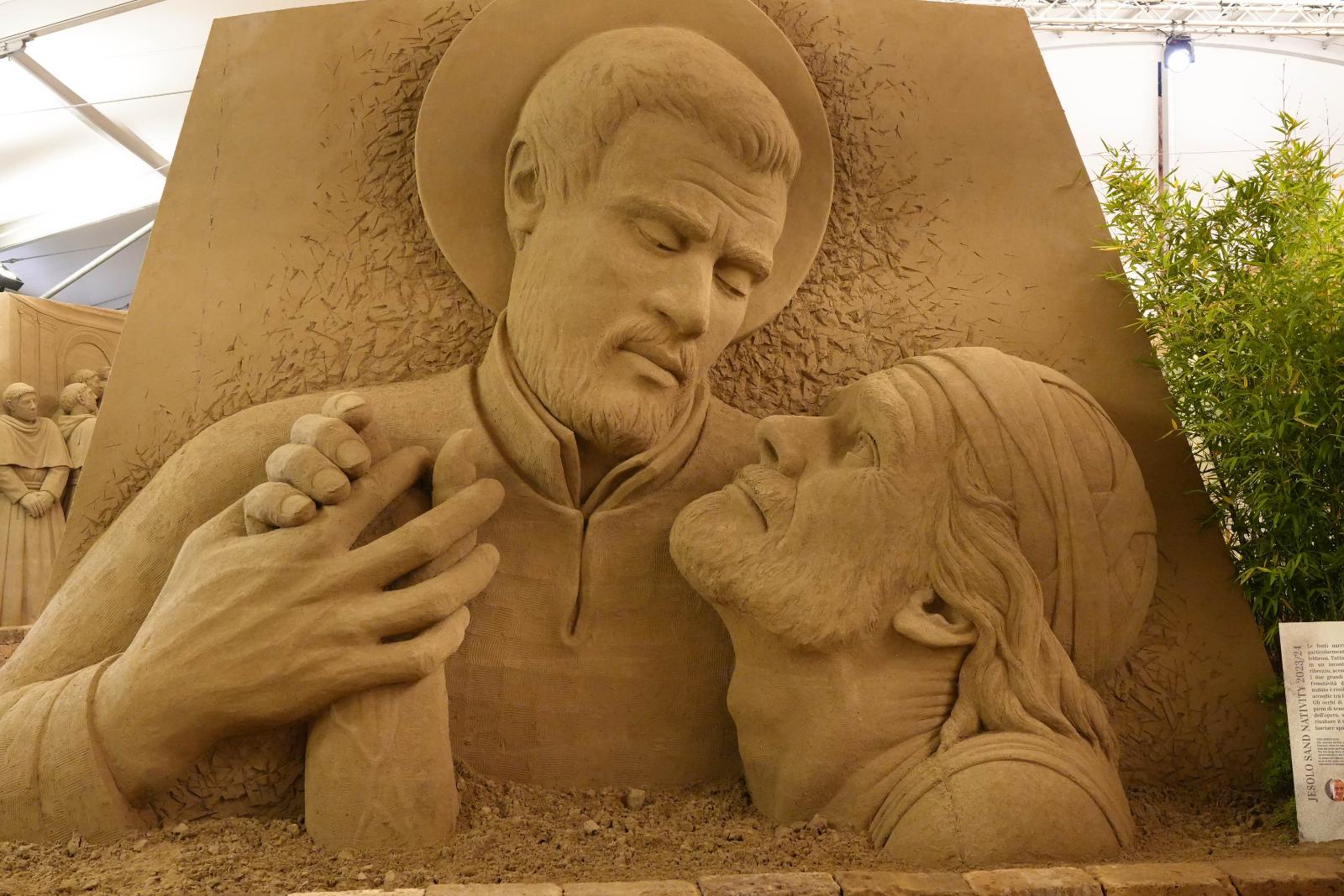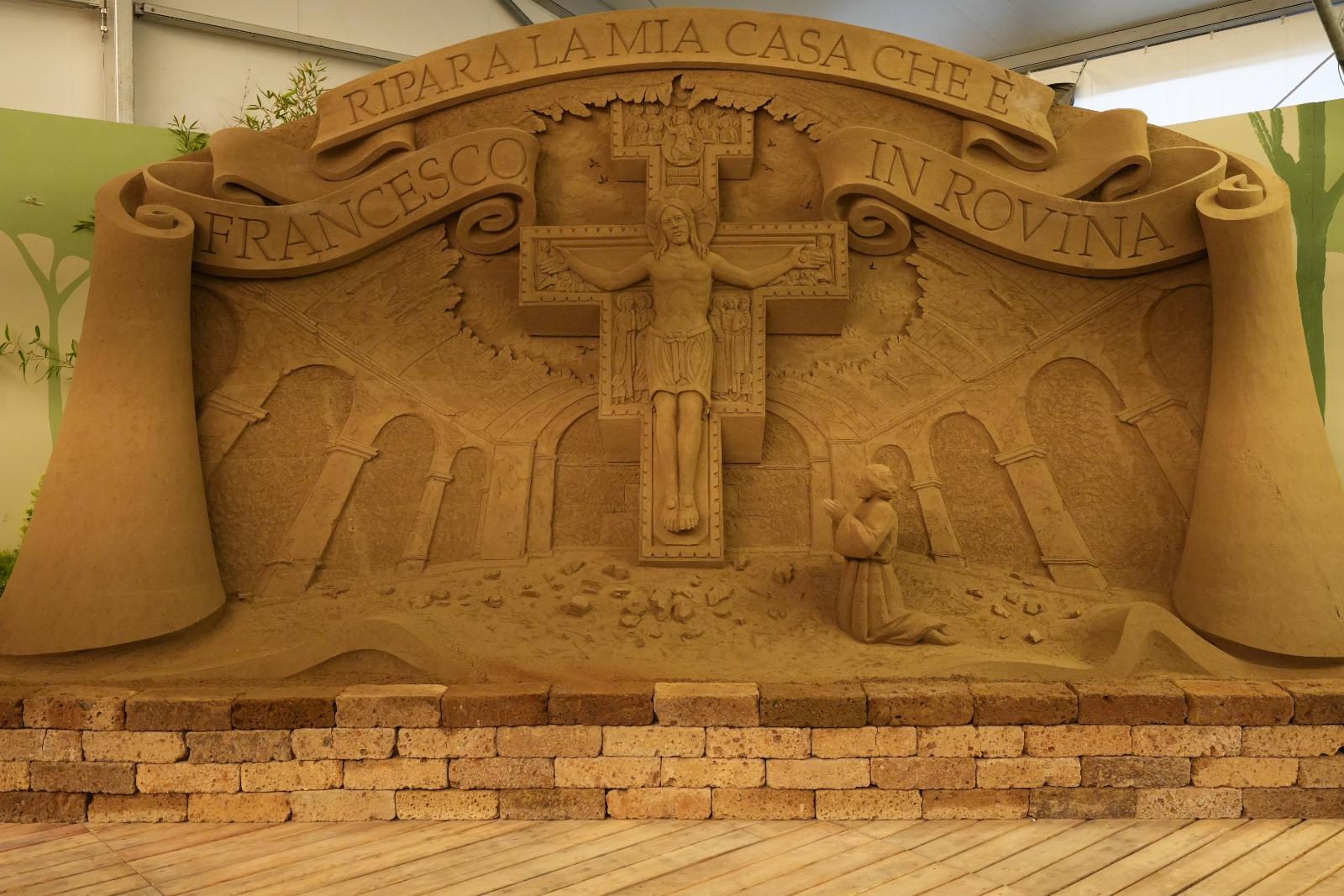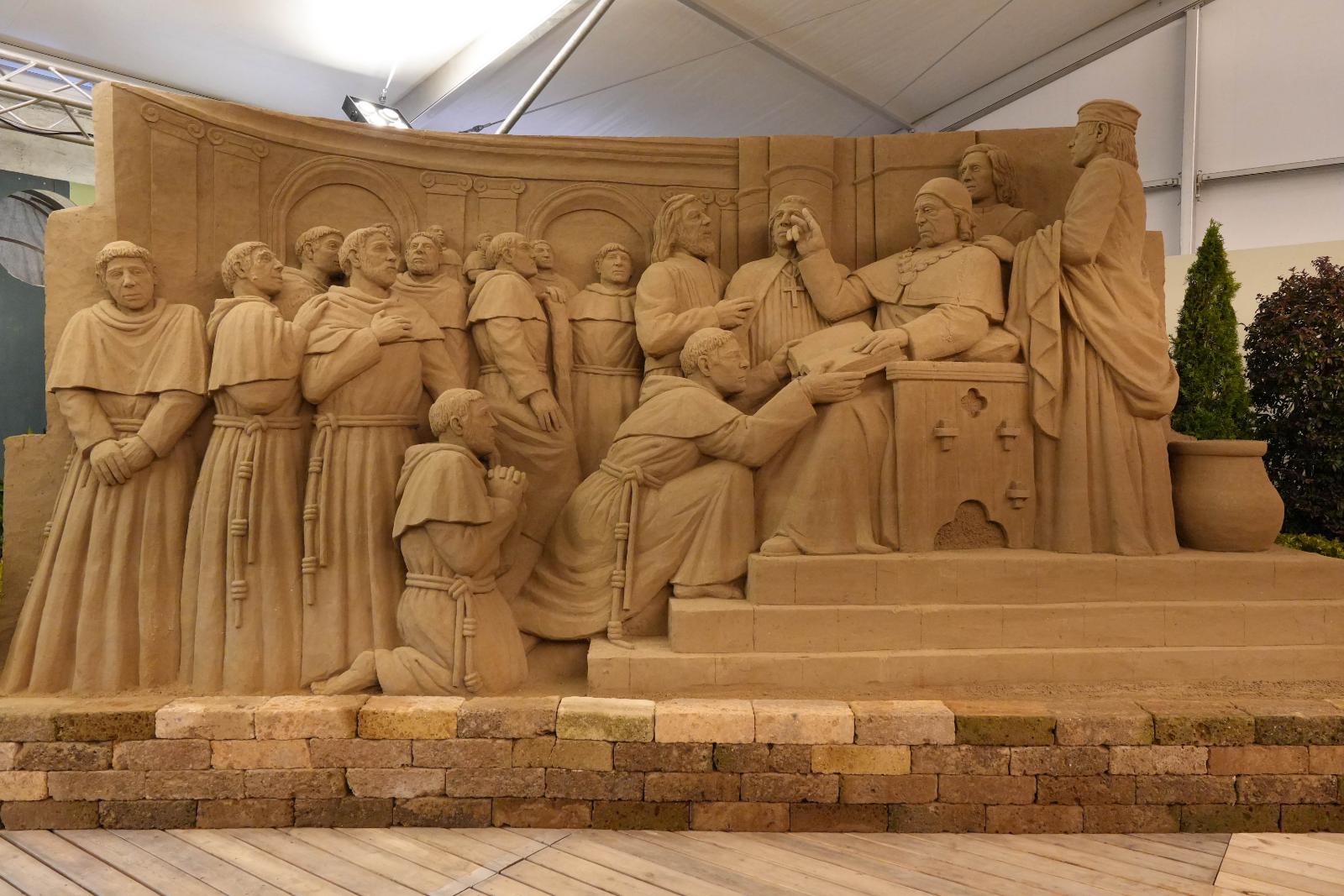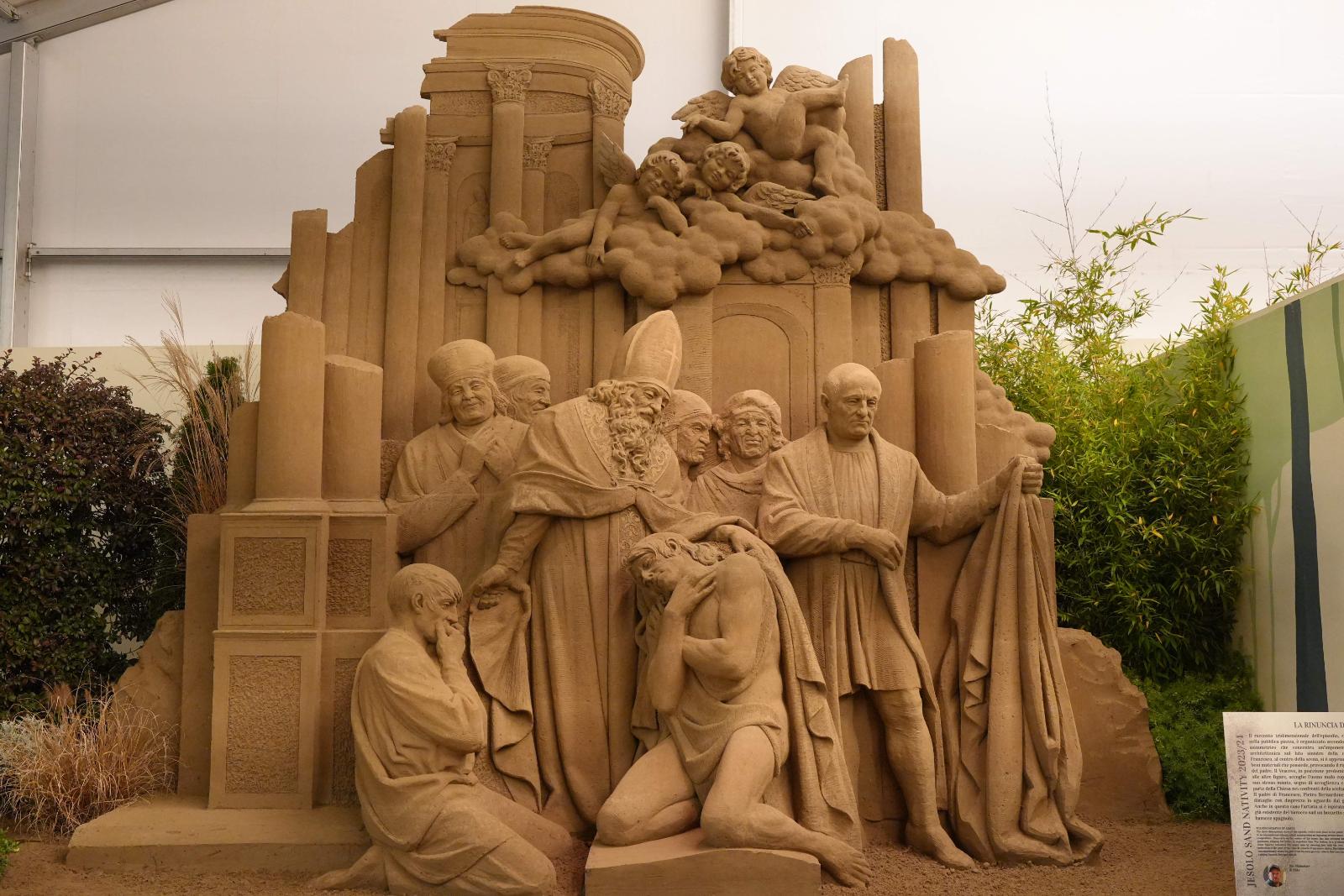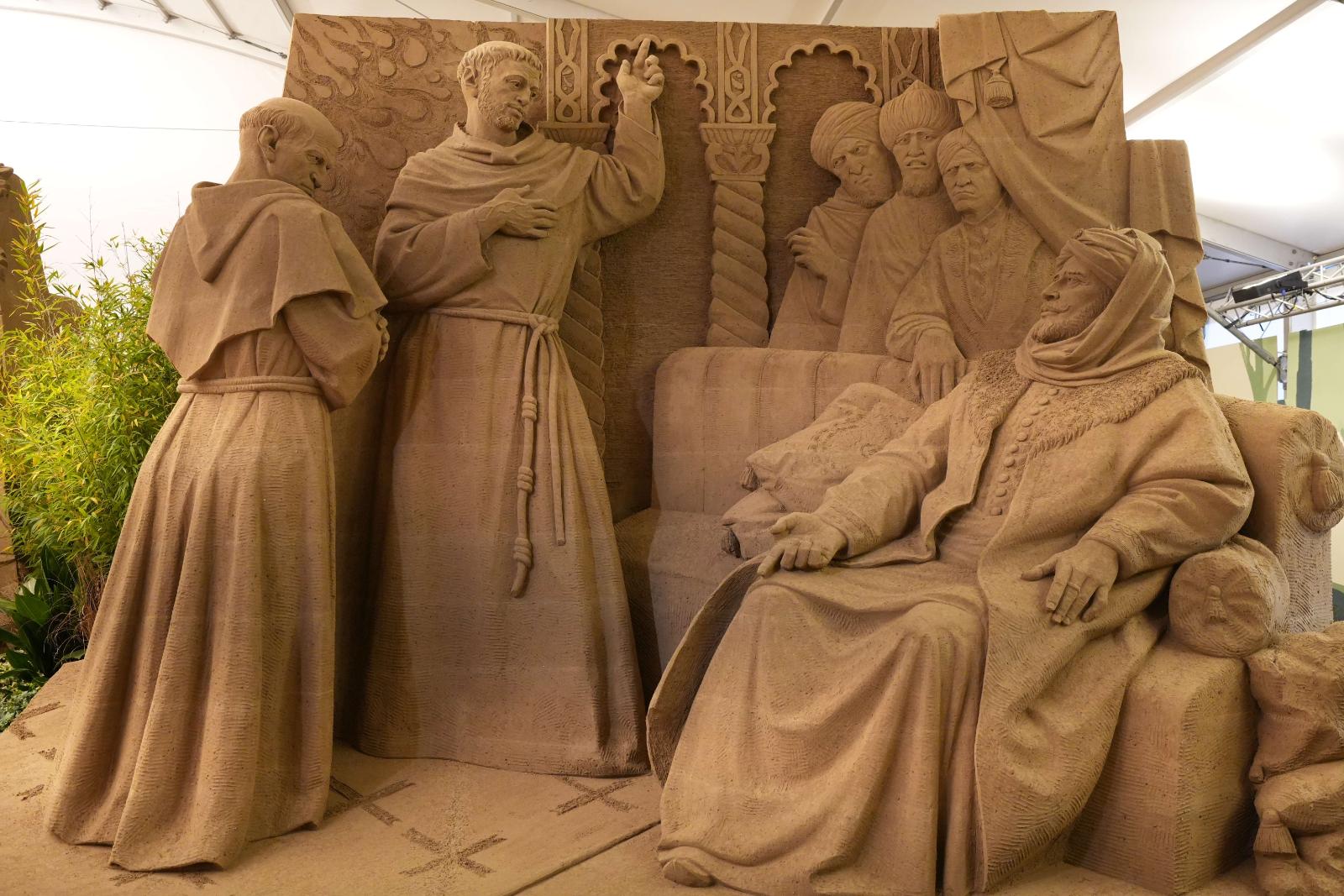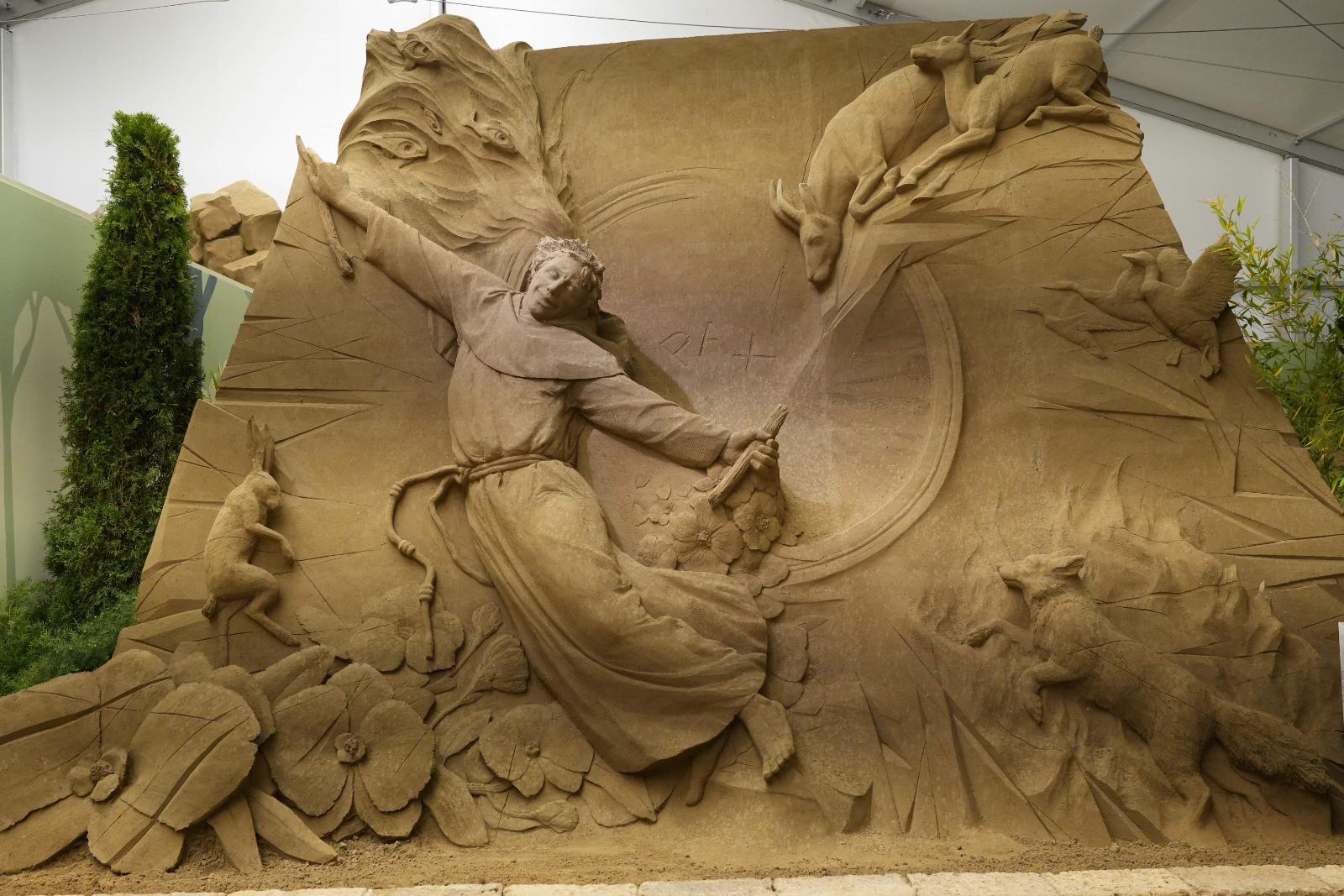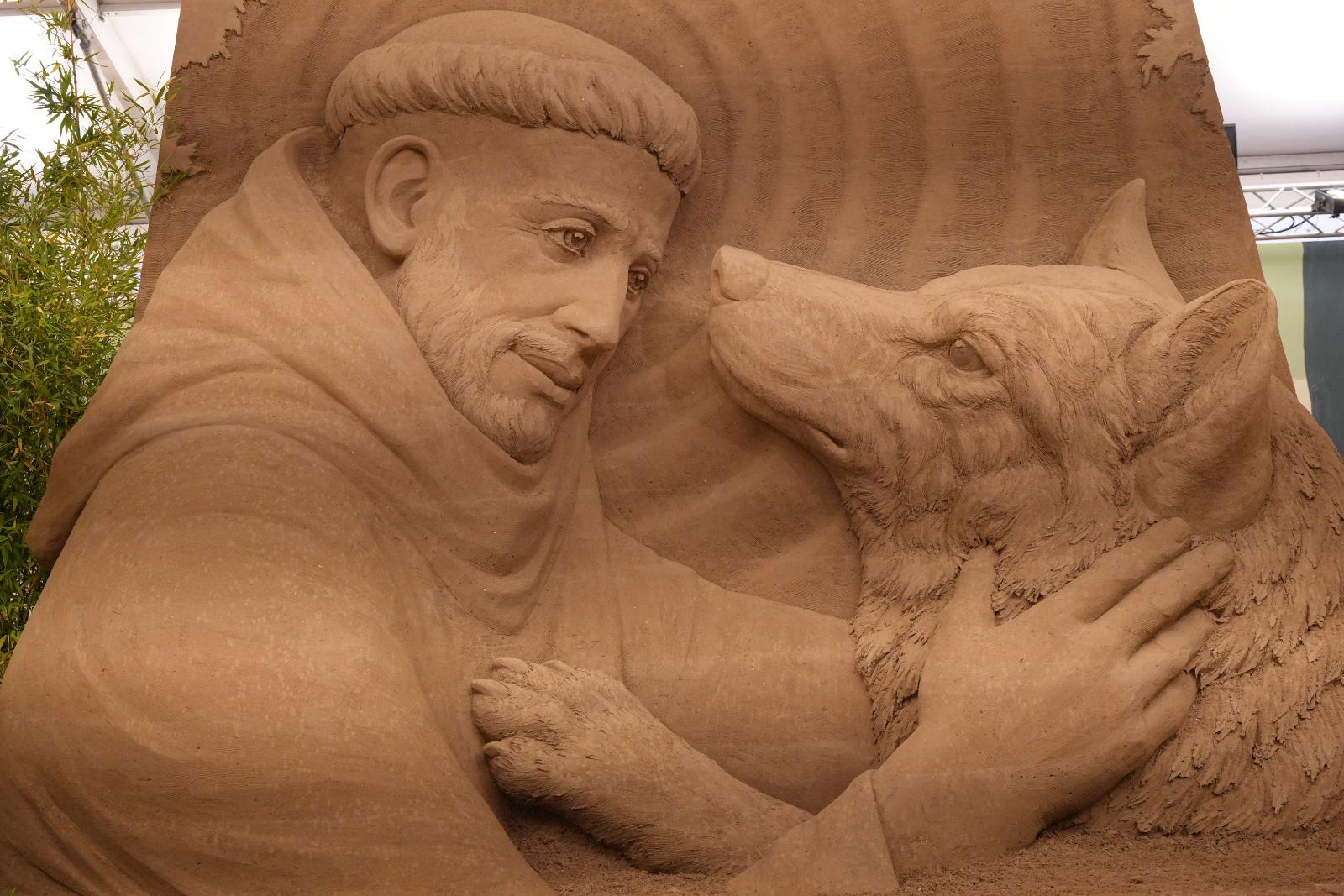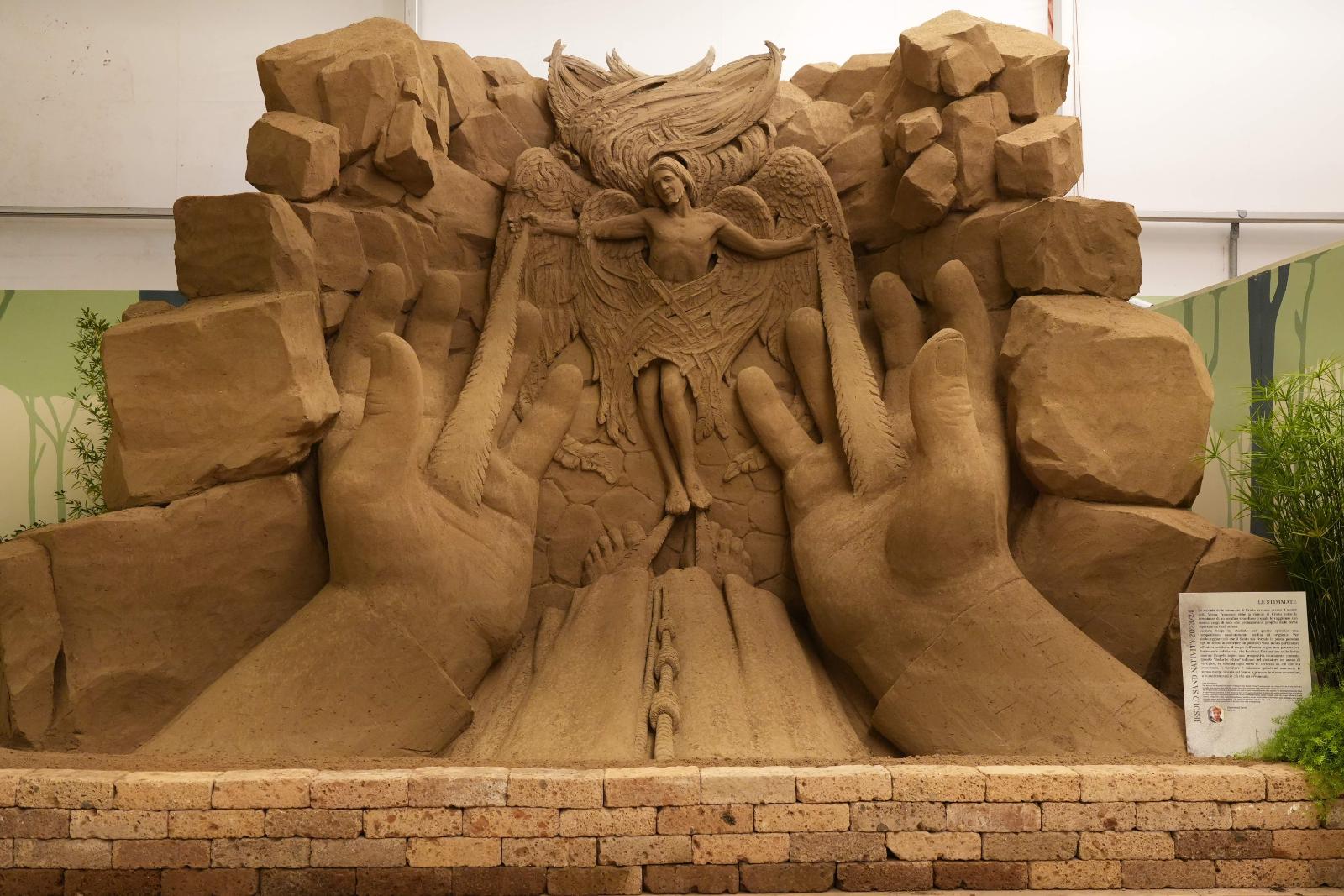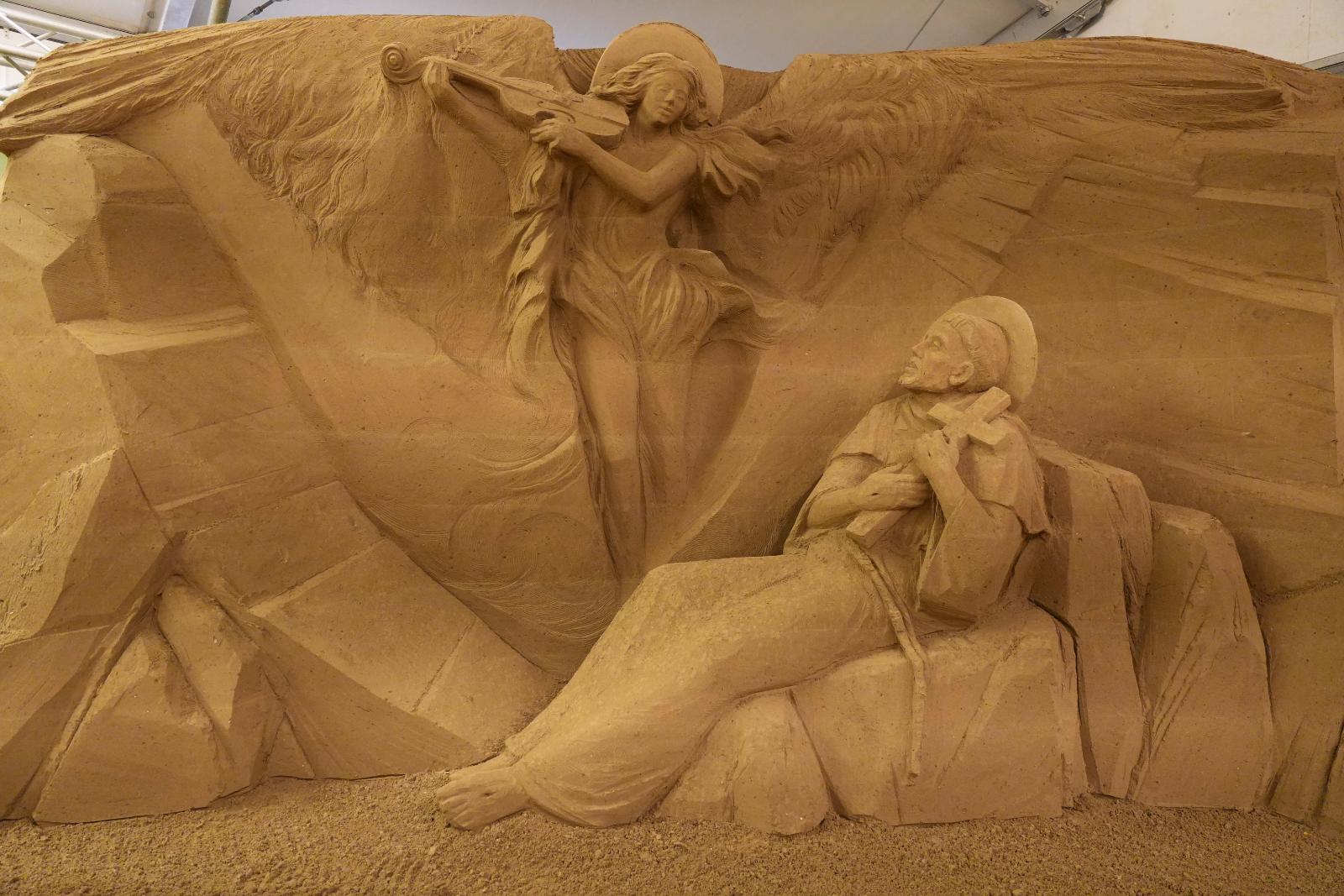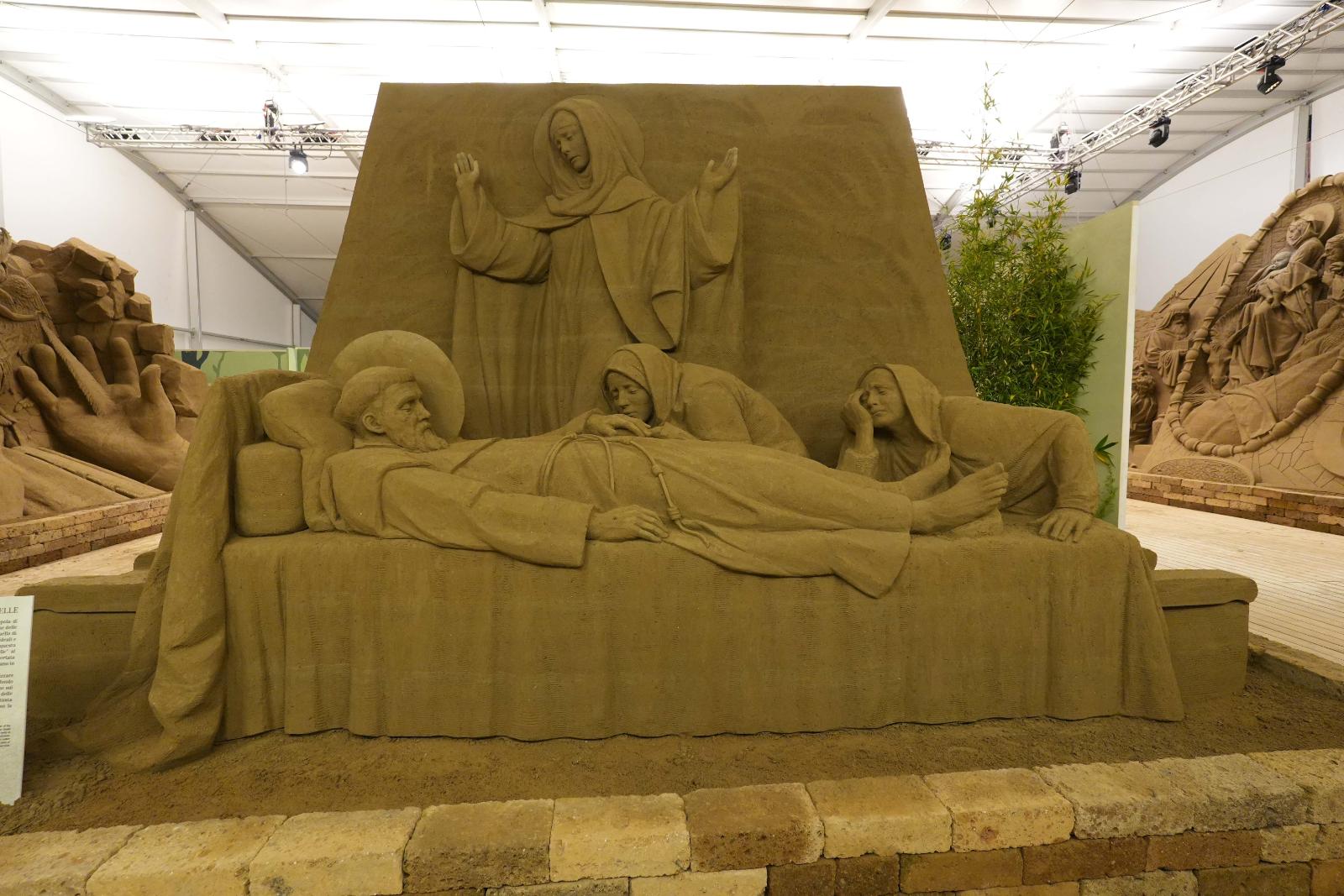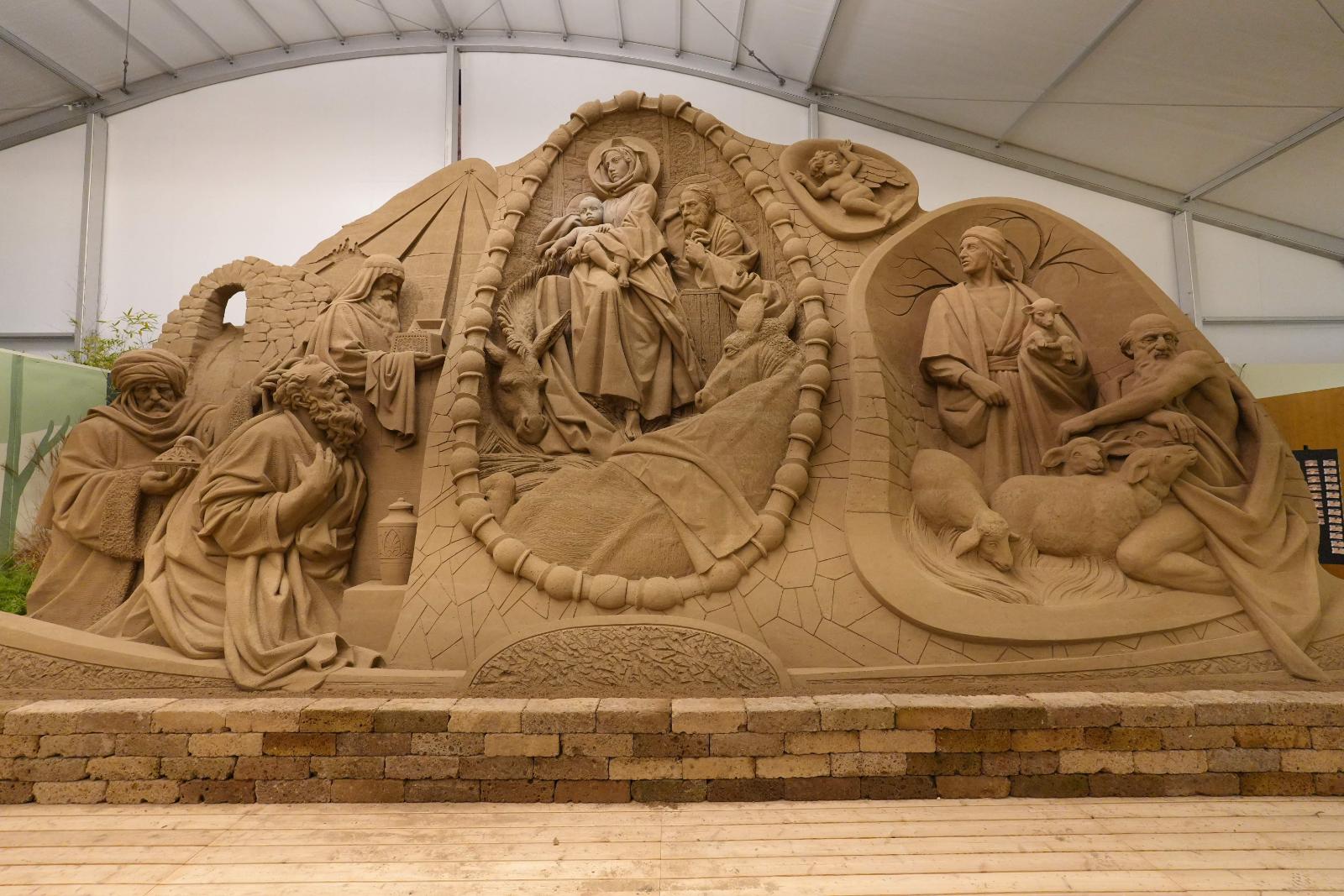
The Works
The theme chosen for the twenty-first edition of Jesolo Sand Nativity 2023 is "In the footsteps of Francis of Assisi".
After the editions dedicated to the works of mercy, to the Exodus in the Bible (with reference to the phenomenon of contemporary migrations), and to the theme of Peace, this year Sand Nativity intends to celebrate 800 years since the first nativity scene represented by Saint Francis in Greccio.
A team of 14 internationally renowned professional sculptors represent the most significant episodes in the life of Francis of Assisi thanks to the precious collaboration of the Sacred Convent of Saint Francis in Assisi.
The Sand Sculptures
Preaching to the Birds
Sculptress: Hanneke Supply
At the opening of the exhibition, narrating the events surrounding the life of Saint Francis of Assisi, saint patron of Italy, there is the artwork dedicated to one of the most popular stories of the Saint's life.
The episode narrates how Francis, driven by a tender love and great pity for other creatures, urged a group of birds to listen to the word of God.
The figure of the man is surrounded by various species of birds, which listen to him attentively and without fear, hovering lightly in the air or crouching at his feet.
Two trees frame the scene, setting it in a natural landscape very frequent in stories linked to Saint Francis, a symbol of simplicity and a strong reference to his connection with nature.
The kiss to the leper
Sculptor: Pedro Mira
The sources narrate how the young Francis was particularly troubled and felt repugnance towards lepers. However, when he happened to meet one in a chance encounter, instead of listening to his disgust, he dismounted from his horse and hugged and kissed it.
The two large faces of the characters convey all the emotion of the scene. The suffering gaze of the sick person is turned sweetly to the figure of the Saint who welcomes him in his arms, holding him by the hand. Francis' eyes are no longer derogatory but full of tenderness towards those who suffer. The background of the work, as simple as the soul of the main actor, highlights the tender relationship between the two characters, leaving no room for any digression of thoughts.
The prayer to the crucifix
Sculptor: Jakub Zimacek
One of Francis' places of prayer was the dilapidated church of San Damiano, near Assisi. One day while he was praying in front of the crucifix, the latter became animated and said: "Go Francis, repair my house which is falling into ruin". It is understandable how this phrase was a metaphor, which invited Francis not only to repair the small church on a structural level, but how he had been urged to renew the whole Church, made of believing people, and its institutions. The compositional structure of the artwork highlights the phrase pronounced by the crucifix, which stands out in the center of the composition expertly worked in low relief. The architecture in serious decline frames the scene, giving it great drama.
The Rule
Sculptor: Baldrick Richard Buckle
In 1223 Pope Onorio III approved the Rule of life of Francis of Assisi and his friars.
With this document, Saint Francis intended to give the community of brothers who followed him both the spiritual direction of the nascent Franciscan Order and a series of practical rules intended to regulate their daily life. The fulcrum of the composition is located in the right area of the large block of sand, where Francesco is kneeling at the Pope's feet at the moment of approval of the important document. Precisely the 3 knots on the belt of the Saint recall the 3 Franciscan rules of life "Observe the Holy Gospel of our Lord Jesus Christ, living in obedience, without anything of one's own and in chastity."
The artist took inspiration from a large eighteenth-century painting preserved in Palazzo Barberini in Rome which narrates the same episode, reinterpreting it three-dimensionally.
The renunciation of assets
Sculptor: Ilya Filimontsev
The three-dimensional story of the episode, which took place in the public square, is organized according to an asymmetrical scheme which concentrates an imposing architectural structure on the left side of the composition. Francis, at the center of the scene, has just stripped himself of the material goods he possesses, causing his father to repudiate him. The bishop, in a predominant position compared to the other figures, welcomes the naked man by covering him with his own mantle, a sign of welcome and protection of the part of the Church towards Francis' choice. His father, Pietro Bernardone, on the left, contemptuously averts his gaze from his son's gesture. Also in this case the artist was inspired by an already existing Spanish Baroque sketch.
Francis to the Sultan
Sculptor: Dmitrii Klimenko
In 1219, during the Fifth Crusade, Francis embarked to reach the Holy Land and it was during this journey that he met the Sultan al-Malik al-Kamil. All the main sources of the time agree in presenting the spirit of courage that animated Francis and the wisdom that characterized the Sultan. The sculpture depicts this event by placing the two groups opposite each other, with Francis standing on the carpet decorated with cruciform motifs, in a predominant position in front of the Sultan who listens to him comfortably seated. Other characters observe the scene with interest, probably doubtful about the outcome of the meeting.
The episode is remembered as an important moment of exchange between Christian and Islamic cultures.
Francis plays the viola
Sculptress: Michela Ciappini
The sources tell how Saint Francis was particularly attracted by music. Sometimes it could happen that he picked up a piece of wood from the ground and, while holding it on his left arm, with his right hand he took a bow held curved by a wire and used it as if it were a viola, singing the praises of the Lord in French.
The composition that the artist created revolves around the sense of circularity; a circumference frames the scene creating two different worlds: externally there is the world we live in, as we know it, which however appears distorted, a deformed reality, as can be seen from the shapes that compose it. Inside the bubble there is the true essence of things, the one experienced by Francis. The Saint, through music, comes into contact with the elements of creation, with the intention of reconnecting to the origins of the natural world, pure and simple as it was at the beginning.
Francis and the wolf
Sculptress: Susanne Marguerite Ruseler
The well-known story tells how Francis arrived in the town of Gubbio and found the inhabitants frightened by the presence of a ferocious wolf in the surrounding area who was tormenting them. Having found the animal just outside the city, he blessed it, making a pact of mutual respect with it: the wolf would no longer torment the citizens and would be rewarded with hospitality and food. The pact was respected by both parties until the animal's death, with great gratitude for the intervention of Saint Francis.
The sculpture portrays the face of Saint Francis flanked by the muzzle of the wolf. The oversizing of the subjects allows us to admire the expressiveness of the faces and the artist's attention to the smallest details.
The stigmata
Sculptor: Enguerrand David
The story of the stigmata of Christ took place near Mount Verna; Francis had the vision of Christ in the guise of a crucifix who reached him with five rays of light that emanated from the wounds sustained by Jesus himself.
The Belgian artist studied an absolutely new and original composition for this episode. To symbolize what the Saint is experiencing firsthand, he has chosen to give a very particular point of view to the entire sculpture: the man's body follows a strongly emphasized perspective, which focuses attention on the wounds, while the Angel follows a totally central perspective. This "optical disturbance" instills a sense of dizziness in the visitor and eliminates any sort of certainty about what is happening. The visitor is therefore called to take on the same point of view as the Saint, to experience the same sensations, to identify with what is happening.
The angels play for him
Sculptress: Helena Bangert
As Saint Bonaventura (one of the major biographers of Saint Francis) recounts: "Once the Saint, prostrate by many illnesses at the same time, felt the desire for some beautiful music, which would give him back the joy of the spirit. Convenience and decorum did not allow this to happen by men, and then the obliging angels intervened to make his wish come true."
On the left, the sculptor portrays the Saint, during his last days of life, with a face hollowed out by pain, but from whose expression shines the peace and joy that the music, played by the angel, manages to instill in his soul. Rays of light radiate from the instrument, focusing the viewer's attention on the face of the Saint.
Chiara and the sisters
Sculptress: Marielle Heessels
Chiara d’Assisi was a great follower and disciple of Francis and is known as the founder of the order of the Poor Clares. His figure is closely connected to that of Saint Francis as they immediately followed the same ideals and lifestyles aimed at simplicity and humility.
This sculpture depicts the farewell of the "sisters" to the body of the Saint, whose body is specially brought to the convent of San Damiano where the women lived in seclusion.
Also on this occasion the artist chose to organize the composition by positioning the figures on a sober background, without any decoration, to focus attention on the feelings that the characters feel: the great pain of the women is emphasized by their theatrical gestures, borrowed by the artist from various works of the past that reproduce the same scene.
Nativity
Sculptors: Radovan Zivny, Vadim Gryadov, Wiaczeslaw Borecki
2023 marks the eighth centenary of the Christmas in which Saint Francis created the first nativity scene in the village of Greccio.
It was the year 1223 when, after the approval of the Rule, he asked the Pontiff for permission to represent the Nativity in order to create an event that still marks the history of our land today and which has become a traditional symbol throughout the Christian world to remember the birth of Christ.
3 artists worked together to sculpt the large block of sand: the Holy Family, framed by a decorative motif aimed at attracting the viewer's attention, flanked on the left by the group of the Three Wise Men, dominated by a bright comet star. On the right, the group of simple shepherds, expertly worked and with attention to every detail, emphasizes the religious value of bringing Christ closer to Man, so that the latter can better welcome him and let himself be loved.


